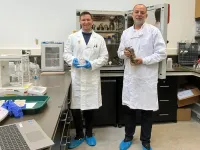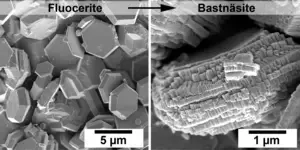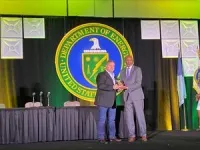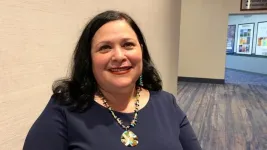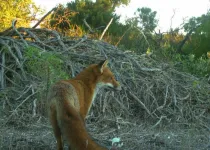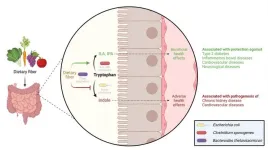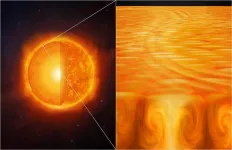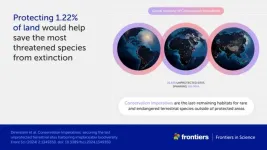New study unveils formation secrets of tiny rare earth elements
2024-06-25
(Press-News.org)
Researchers from Trinity College Dublin’s School of Natural Sciences have revealed a novel route to the formation of bastnäsite, a crucial mineral for the extraction of rare earth elements (REEs). Their work offers promise in one day making the extraction of these REEs more efficient.
The study – published today in the journal Nanoscale – uncovers for first time how fluocerite, a rare mineral, quickly forms and transforms into bastnäsite. The occurrence and origin of fluocerite in natural deposits was not fully understood, and it has been very difficult for earth scientists to study this mineral in natural samples.
Now, the Trinity team has revealed a new crystallisation route that produces extremely tiny, nanometric-sized minerals. Some of these elusive minerals are incredibly small, just a few billionths of a meter in size, making them very difficult to observe in natural samples.
Their research has essentially found that fluocerite can act as a “seed” to promote the rapid formation of bastnäsite.
This new knowledge not only advances scientific understanding but also has practical implications, potentially leading to more efficient and cost-effective methods for extracting REEs, which are vital for a wide range of technologies, from smartphones to renewable energy solutions. They are also crucial for researchers who have struggled to understand the intricate factors and pathways involved in the formation of these tiny, nanometric minerals.
First author of the research, Dr Luca Terribili, Trinity, said: “Earth science researchers working with natural samples have found it extremely challenging to understand all the factors controlling the formation of bastnäsite, which is the main industrial source of rare earth elements, as well as the various potential pathways of its formation. Here, we have shown for the first time that fluocerite can turn into bastnäsite.
“This discovery has been made by following a completely different approach – we buillt synthetic bastnäsite rocks in the laboratory, to mimic the same processes occurring in nature— and studied them with powerful spectroscopic and microscopic techniques. This approach not only helped to clarify the complex natural processes at play but also paves the way for more efficient extraction of rare earth elements.”
Principal Investigator, Prof. Juan Diego Rodriguez-Blanco, Trinity, added: “Our study highlights how these transformations can occur at relatively low temperatures, and very quickly. These insights are crucial for developing better industrial methods for extracting rare earth elements. The reaction that turns fluocerite to bastnäsite may seem a slower process, taking between five hours and a month depending on temperature, but it is very rapid in geological timescales.”
END
ELSE PRESS RELEASES FROM THIS DATE:
2024-06-25
ALBUQUERQUE, N.M. — The Department of Energy has once again awarded Sandia National Laboratories for its work helping small businesses. One of those businesses, owned by a disabled veteran, was also awarded for its extraordinary work.
DOE Mentor of the Year
Sandia’s small business Mentor-Protégé Program has been named as DOE Mentor of the year, an award it has received for three consecutive years.
Now in its fifth year, the program has mentored five protégés from around the country. More than 150 volunteer mentors and support personnel help these small and disadvantaged businesses grow, succeed and navigate doing business ...
2024-06-25
PULLMAN, Wash. – Your mom might be a better health influencer than Dwayne “The Rock” Johnson.
Adults in a study who said they looked to a person they knew as role model for good health—such as a friend, relative or healthcare provider—rather than a celebrity, had greater motivation to reach their health goals. The women participants were also more likely than men to choose a personal role model rather than a celebrity. And the person most often named was their own mother.
“We know that parents have a huge influence on shaping people’s health trajectories throughout their life just ...
2024-06-25
Giant lizards called heath goannas could save Australian sheep farmers millions of dollars a year by keeping blowfly numbers down - and must be prioritised in conservation schemes to boost native wildlife, say researchers.
A study led by the University of Cambridge has found that heath goannas - a species of giant, scavenging lizard - act as natural clean-up crews by clearing maggot-ridden animal carcasses from the landscape.
This reduces the emergence of blowflies, which attack sheep by laying eggs on their backsides that hatch into flesh-eating maggots. The disease, known as ‘fly strike’, costs the Australian sheep farming industry an estimated $280 million a year.
This ...
2024-06-25
This process is currently not included in models that predict sea level rise, so the new results could offer a more accurate picture of how the world will change with global warming and how much coastal areas will need to adapt.
Carried out by scientists at the British Antarctic Survey (BAS), the findings are published in the journal Nature Geoscience.
“We have identified the possibility of a new tipping-point in Antarctic ice sheet melting,” says Alex Bradley, an ice dynamics researcher ...
2024-06-25
We get healthy dietary fibres from consuming fruits, vegetables, and whole grains. But why are the fibres so good for us? A team of researchers has discovered that dietary fibres play a crucial role in determining the balance between the production of healthy and harmful substances by influencing the behaviour of bacteria in the colon.
Dietary fibres benefit our health, and scientists from DTU National Food Institute and the Department of Nutrition, Exercise and Sports at the University of Copenhagen have now uncovered an essential part of why this is the case. Different types of bacteria inside our colon compete to utilize an essential amino acid called tryptophan. This competition ...
2024-06-25
The largest and most ethnically and geographically comprehensive investigation to date of the gut microbiome of people with type 2 diabetes (T2D), prediabetes, and healthy glucose status has found that specific viruses and genetic variants within bacteria correspond with changes in gut microbiome function and T2D risk. Results of the study—which represents a collaboration across Brigham and Women’s Hospital (a founding member of the Mass General Brigham healthcare system), the Broad Institute of MIT and Harvard, and Harvard T.H. Chan School of Public Health—are published in Nature Medicine.
"The microbiome is highly variable across different geographic ...
2024-06-25
Abu Dhabi, UAE, June 25, 2024: A team of solar physicists at NYU Abu Dhabi’s Center for Astrophysics and Space Science (CASS), led by Research Scientist Chris S. Hanson, Ph.D., has revealed the interior structure of the sun’s supergranules, a flow structure that transports heat from the sun’s hidden interior to its surface. The researchers’ analysis of the supergranules presents a challenge to the current understanding of solar convection.
The sun generates energy in its core through nuclear fusion; that energy is then transported to ...
2024-06-25
A genetic variation common in people of African ancestry is associated with an increased risk of complications from diabetes, including diabetic retinopathy, according to a report published June 25 in the journal Nature Medicine.
The investigators found that the diagnosis of diabetes and treatment needed to prevent diabetes complications may be delayed in people who carry the variant, G6PDdef, because it is associated with reduced levels of HbA1c, a widely used clinical marker of blood glucose levels.
Testing for genetic variations that cause G6PD ...
2024-06-25
In a groundbreaking new article, a coalition of conservationists and researchers have shown how we can protect Earth’s remaining biodiversity by conserving just a tiny percentage of the planet’s surface. This affordable, achievable plan would make it possible for us to preserve the most threatened species from extinction, safeguarding Earth’s wildlife for the future.
“Most species on Earth are rare, meaning that species either have very narrow ranges or they occur at very low densities ...
2024-06-25
Today, the FRONTIERS Science Journalism Initiative opens the second call for applications for its science journalism in residency programme. The application period will remain open until the 25th of September 2024, at 17:00 CEST.
Funded by the European Research Council (ERC), this initiative offers science journalists the opportunity to develop independent journalism while spending three to five months in a host research institution, located in an EU Member State or a country associated with the EU’s Horizon Europe Programme. The residency ...
LAST 30 PRESS RELEASES:
[Press-News.org] New study unveils formation secrets of tiny rare earth elements
